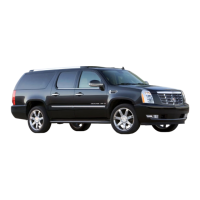
Do you have a question about the Cadillac 2013 XTS and is the answer not in the manual?
| Brand | Cadillac |
|---|---|
| Model | 2013 XTS |
| Category | Automobile |
| Language | English |
Overview of the instrument panel, including its components and their functions.
Provides a brief overview of important features for initial vehicle operation.
Details on various features found in the vehicle, such as radio and infotainment.
Information on traction control, StabiliTrak, tire pressure monitoring, and engine oil.
Information on vehicle keys, remote keyless entry system, door locks, and safety locks.
Details regarding vehicle doors, including trunk operation and warnings about exhaust gases.
Information on vehicle security features, including the alarm system and arming/disarming procedures.
Details on convex mirrors, power mirrors, folding mirrors, and turn signal indicators.
Information on power windows, express features, anti-pinch override, and window lockout.
Operation of the sunroof and sunshade, including vent, express, and anti-pinch features.
Proper adjustment and function of head restraints for occupant safety.
Details on power seat adjustment, lumbar support, thigh support, and memory features.
Instructions on folding seatbacks, locking/unlocking, and heated rear seats.
Proper use of safety belts, including questions and answers, and lap-shoulder belt instructions.
Information on airbag locations, system checks, and warnings for safe operation.
Guidance on securing older children, infants, and using LATCH systems.
Details on instrument panel storage, glove box, cupholders, and console storage.
Information on cargo tie-downs, cargo management system, and convenience net.
Explanation of various warning lights, gauges, and indicators on the instrument cluster.
Overview of the instrument cluster layout and display configurations.
Options for customizing the instrument cluster display: Simple, Performance, Balanced, Enhanced.
Information displayed in the cluster: Navigation, Audio, and Phone applications.
Details on the DIC display, its information options, and messages.
Information on the HUD system, its display, adjustment, and troubleshooting.
Explanation of various vehicle messages displayed on the DIC for status and actions.
Controls for exterior lamps, including automatic headlamps and adaptive forward lighting.
Details on operating the turn signal/lane change lever for exterior lighting.
How the automatic high-beam system adjusts headlamps based on traffic and conditions.
Instructions for operating the high/low-beam changer and understanding indicator lights.
Operation of the hazard warning flashers and automatic activation during airbag deployment.
How to use the turn signal lever and interpret instrument cluster indicators.
Information on instrument panel illumination, courtesy lamps, dome lamps, and reading lamps.
Details on entry lighting, exit lighting, battery power protection, and exterior lighting saver.
Overview of the infotainment system and safety warnings for usage while driving.
How the system is controlled via faceplate buttons and steering wheel controls.
Settings for radio preferences, including managing favorites and tuning stations.
Information on SiriusXM Satellite Radio service, channels, and messages.
Details on CD player capabilities, MP3 CD playback, and USB/iPod/SD card/Auxiliary jack usage.
Overview of cell phone interaction with the infotainment system via Bluetooth.
Instructions for using cell phones with the infotainment system, including hands-free calling.
Step-by-step guide to pairing cell phones and devices with the vehicle's Bluetooth system.
Methods for making calls using the phone book, call lists, keypad, or voice commands.
Legal information, including FCC rules and software licenses.
Overview of the dual automatic climate control system and its buttons.
How the system automatically controls fan, air delivery, AC, and recirculation for comfort.
Manual control of fan speed, temperature, and air delivery modes.
Adjusting climate settings for the rear passenger area via buttons and touch screen.
Details on adjustable air vents located in the center and on the instrument panel.
Information on the air filter's function, replacement schedule, and inspection.
Guidance on safe driving practices, including avoiding distraction and drunk driving.
Tips to avoid distractions and focus on the task of driving.
Principles of defensive driving, emphasizing anticipating unexpected events and wearing safety belts.
Factors important for vehicle control: braking, steering, and acceleration.
Tips for effective braking, including reaction time and following distance.
Information on variable effort steering, hydraulic power steering, and curve tips.
Understanding and responding to skidding and loss of control situations.
Precautions for driving in rain and wet conditions, including hydroplaning.
Guidance for driving in snow or ice, including blizzard conditions.
Tips for getting the vehicle unstuck from sand, mud, ice, or snow.
Information on vehicle capacity weight, tire loading, and gross vehicle weight ratings.
Guidelines for new vehicle break-in and proper ignition positions.
Explanation of the keyless ignition modes: ACC/ACCESSORY, ON/RUN/START, OFF.
Procedure for starting the engine, including with a low transmitter battery or computer-controlled cranking.
Warnings and precautions regarding engine exhaust and carbon monoxide.
Operation of the automatic transmission, including P (Park) and warnings about shifting.
Information on the All-Wheel Drive system and its operation.
Details on the Antilock Brake System (ABS), brake assist, and emergency braking.
How the ABS system works, its warnings, and how to use it.
Operation of the EPB system, including apply, release, and warning lights.
Explanation of the brake assist feature for emergency driving conditions.
Functionality of the HSA feature to prevent rolling on grades.
Details on Traction Control System (TCS) and StabiliTrak® System.
How the TCS limits wheel spin and its operation in slippery conditions.
How StabiliTrak assists with directional control in difficult driving conditions.
How the Magnetic Ride Control monitors and adjusts the suspension system.
Operation of the automatic level control rear suspension system.
Safety warnings and operational guidelines for using cruise control.
Features and operation of Adaptive Cruise Control (ACC) for maintaining speed and gap.
Overview of systems that help avoid crashes or reduce damage while driving.
Details on Rear Vision Camera (RVC) and Rear Parking Assist systems.
How the FCA system helps avoid or reduce harm from front-end crashes.
System including Intelligent Brake Assist (IBA) and Automatic Collision Preparation (ACP).
How LDW helps avoid crashes due to unintentional lane departures.
Information on recommended fuel, additives, and filling the tank.
Safety warnings and instructions for refueling the vehicle.
General towing information, driving characteristics, and tips for towing trailers.
Information on selecting and installing correct towing equipment like hitches and safety chains.
Precautions and considerations when adding electrical equipment to the vehicle.
Importance of maintenance and services, dealer information, and GM parts.
Guidance on performing basic service work and consulting the service manual.
Instructions on how to open and close the vehicle hood safely.
Diagram and identification of components located in the engine compartment.
Importance of engine oil, proper selection, and steps for checking and adding oil.
How the system indicates oil change needs and how to reset it.
Information on transmission fluid leaks and recommended fluid change intervals.
Inspection and replacement procedures for the engine air cleaner/filter.
Function of the cooling system and warnings about electric cooling fans.
Information on the DEX-COOL coolant mixture and what to use.
How to handle engine overheating, including protection modes and steam warnings.
When and how to check power steering fluid levels and suspected leaks.
What to use for washer fluid and instructions for adding it, including freezing precautions.
Information on disc brakes, wear indicators, brake pedal travel, and brake adjustment.
Master cylinder reservoir, fluid level checks, and warnings about using the wrong fluid.
Information on battery replacement, warnings about battery components, and vehicle storage.
Details on the transfer case fluid and maintenance for AWD systems.
Procedure for checking the starter switch and warnings about vehicle movement.
Checks for the parking brake and P (Park) mechanism, including warnings about vehicle movement.
Inspection and replacement procedures for windshield wiper blades.
Considerations for windshield replacement, especially for vehicles with HUD.
Information that headlamp aim is preset and may need dealer adjustment after a crash.
Guidance on proper replacement bulbs and procedures for HID and LED lighting.
Instructions for replacing back-up lamp bulbs.
Procedures for replacing license plate lamp bulbs.
Protection against electrical system overload via fuses and circuit breakers.
Information on checking and replacing fuses and circuit breakers.
Location and access instructions for the engine compartment fuse block.
Location and access instructions for the instrument panel fuse block.
Location and access instructions for the rear compartment fuse block.
General information on tires, wheels, and safety precautions.
Safety warnings about tire maintenance, usage, and replacement.
Features and performance of all-season tires, and when to consider winter tires.
Benefits of winter tires for snow/ice, and considerations for their use.
Performance of summer tires and recommendation for winter tires in cold climates.
Explanation of tire size, TPC Spec, DOT code, and other sidewall information.
Importance of correct tire pressure and consequences of under/overinflation.
Inflation pressure adjustments for high-speed driving and warnings.
How the TPMS warns about low tire pressure and monitors air pressure.
Meaning of TPMS malfunction indicator and causes for system errors.
Procedure to match TPMS sensors after tire rotation or replacement.
Recommendations for inspecting tires for wear or damage monthly.
Schedule and importance of tire rotation for uniform wear.
Factors affecting tire wear and when to replace tires.
Recommendations for purchasing tires with the same TPC Spec rating.
Impact of different sized wheels/tires on vehicle performance and safety.
Explanation of UTQG grades for treadwear, traction, and temperature performance.
Importance of wheel alignment and tire balance for tire life and performance.
Guidelines for replacing wheels, bolts, nuts, and TPMS sensors.
Warning against using tire chains due to clearance issues and potential damage.
Tips on handling a flat tire, including what to expect and what to do.
Information on the tire sealant and compressor kit, including warnings and usage.
Step-by-step guide for using the kit to seal and inflate a punctured tire.
Instructions for using the air compressor to inflate a tire with air only.
Procedures for removing and installing the tire sealant canister.
Instructions for accessing and storing the tire sealant and compressor kit.
Steps for removing the spare tire and tools, and changing a flat tire.
Safety precautions and step-by-step instructions for jump starting a vehicle.
Notice regarding incorrectly towing a disabled vehicle and damage coverage.
Considerations for recreational vehicle towing, including dinghy and dolly towing.
Guidelines for washing the vehicle and protecting exterior bright metal parts.
Instructions for washing the vehicle, avoiding damaging agents, and finish care.
Procedures for cleaning interior surfaces, preventing damage, and using proper cleaners.
Guidelines for proper floor mat usage and warnings about pedal interference.
Importance of required maintenance for vehicle performance and value.
Overview of the maintenance program covering services during the first 4 years or 80,000 km.
Schedule of owner checks, services at fuel stops, and monthly checks.
Services for severe commercial use vehicles and annual underbody flushing.
Guidance on battery, belts, brakes, fluids, hoses, lamps, shocks, struts, and tires.
List of recommended fluids, lubricants, and part numbers for vehicle systems.
List of common replacement parts with GM and ACDelco part numbers.
Section to record service dates, odometer readings, and services performed.
Importance of wheel alignment for tire wear and performance, and dealer services.
Tips for keeping the windshield clean and clear for safety and appearance.
How to clean and maintain wiper blades for clear visibility.
Information on Vehicle Identification Number (VIN) and service parts label.
Location and description of the legal vehicle identifier.
Explanation of the engine code within the VIN for vehicle specifications.
Details on the label in the trunk with vehicle identification and options.
Capacities and specifications for the vehicle, including fluids and engine details.
Metric and English capacities for refrigerant, cooling system, oil, fuel, and wheel nut torque.
Details on engine type, VIN code, transmission, and spark plug gap.
Diagram illustrating the routing of the engine drive belt.
Overview of customer satisfaction procedures and dealer interaction.
Steps to resolve concerns with the sales transaction or vehicle operation.
Contacting Cadillac Customer Assistance Center for unresolved concerns.
Utilizing the Better Business Bureau (BBB) Auto Line Program for dispute resolution.
Information on Canada's no-charge mediation/arbitration program for owner disputes.
Contact information for Cadillac Customer Assistance Centers in the US, Canada, and Overseas.
Procedures for reporting safety defects to the US and Canadian governments, and General Motors.
Information on vehicle computers recording performance data and privacy considerations.
Purpose of EDRs in recording crash-related data for system performance analysis.
Information on stored data within the navigation system and deletion instructions.
Explanation of RFID technology used for vehicle functions like tire pressure and security.
FCC and Industry Canada compliance statements for vehicle radio frequency systems.
Introduction to the OnStar system, its services, and status light indicators.
Details on Emergency, Security, and Navigation services available through OnStar.
How to get priority connection to an Emergency Advisor for assistance.
OnStar services like Stolen Vehicle Assistance and Remote Door Unlock.
Information on OnStar navigation requirements and how to receive directions.
Step-by-step guide for requesting and following turn-by-turn navigation.
Information on OnStar Hands-Free Calling and controlling the vehicle via the RemoteLink app.
How OnStar Vehicle Diagnostics performs monthly checks on vehicle systems.
Information on transferring service, reactivation for subsequent owners, and how OnStar works.
Process for transferring OnStar service when vehicle ownership changes.
Steps for reactivating OnStar services after acquiring a used vehicle.
Explanation of available OnStar services and system requirements.












